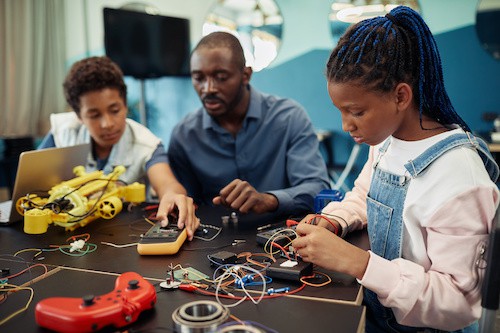In the pursuit of gender equality and diversity in STEM (Science, Technology, Engineering, and Mathematics), it is essential to cultivate girls’ interest in science from an early age. Despite significant progress in recent years, girls continue to be underrepresented in STEM fields, facing barriers that deter them from pursuing careers in science and technology. By fostering a supportive environment and providing opportunities for exploration and learning, we can inspire the next generation of female scientists and engineers and unlock their full potential.
1. Encouraging Curiosity and Exploration
From a young age, girls exhibit curiosity and a natural inclination to explore the world around them. By providing them with opportunities to engage in hands-on activities, experiments, and projects, we can nurture their interest in STEM subjects and ignite their passion for discovery. Science museums, afterschool programs, and STEM-focused camps are excellent resources for exposing girls to a wide range of scientific concepts and encouraging them to pursue their interests.

2. Introducing Role Models and Mentors
Representation matters, especially for girls. Introducing them to female role models and mentors who have succeeded in STEM fields can inspire and empower them to envision themselves as future scientists, engineers, and innovators. Whether through school visits, career talks, or mentorship programs, connecting girls with relatable role models can help dispel stereotypes and demonstrate the diverse opportunities available to them in STEM.
3. Making STEM Education Inclusive and Accessible
Access to quality STEM education is crucial for girls’ participation and success in science. Schools and educational institutions play a vital role in creating inclusive learning environments that cater to diverse interests and abilities. By offering STEM courses, clubs, and extracurricular activities that appeal to girls’ varied interests – from robotics and coding to environmental science and astronomy – we can engage them in meaningful learning experiences and foster their confidence in STEM subjects.
4. Challenging Gender Stereotypes and Bias
Gender stereotypes and bias can significantly impact girls’ perceptions of their abilities and potential in STEM. It is essential to challenge these stereotypes and promote a culture of equality and inclusion in both educational and societal settings. Teachers, parents, and caregivers can play a critical role in encouraging girls to pursue their interests in STEM by providing positive reinforcement, challenging stereotypes, and fostering a growth mindset that emphasizes effort and perseverance over innate ability.

5. Providing Supportive Networks and Communities
Creating supportive networks and communities for girls in science can provide them with the encouragement, resources, and camaraderie they need to thrive in STEM fields. Programs such as Girls Who Code, Girls in Tech, and Women in Science and Engineering (WISE) offer opportunities for girls to connect with like-minded peers, access mentorship and role models, and participate in hands-on learning experiences. By fostering a sense of belonging and empowerment, these initiatives can help girls overcome challenges and pursue their passions in STEM.
Conclusion
Cultivating girls’ interest in STEM is not only essential for achieving gender equality in science but also for unlocking their potential as future leaders and innovators. By encouraging curiosity and exploration, introducing role models and mentors, making STEM education inclusive and accessible, challenging gender stereotypes and bias, and providing supportive networks and communities, we can inspire the next generation of female scientists and engineers to pursue their dreams and make a meaningful impact in the world of STEM. Together, we can foster a future where girls are empowered to reach their full potential and contribute to a more diverse and inclusive scientific community.
